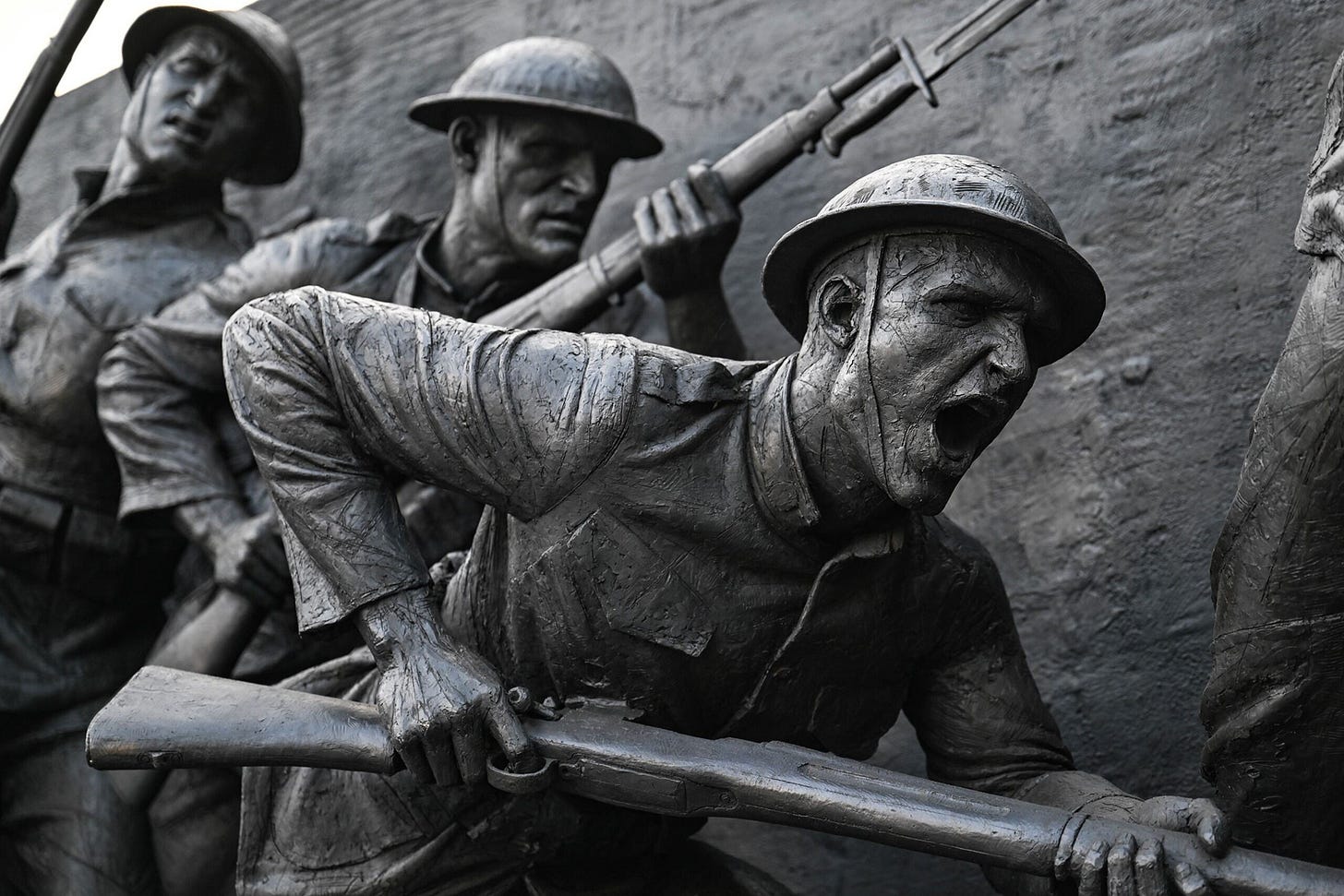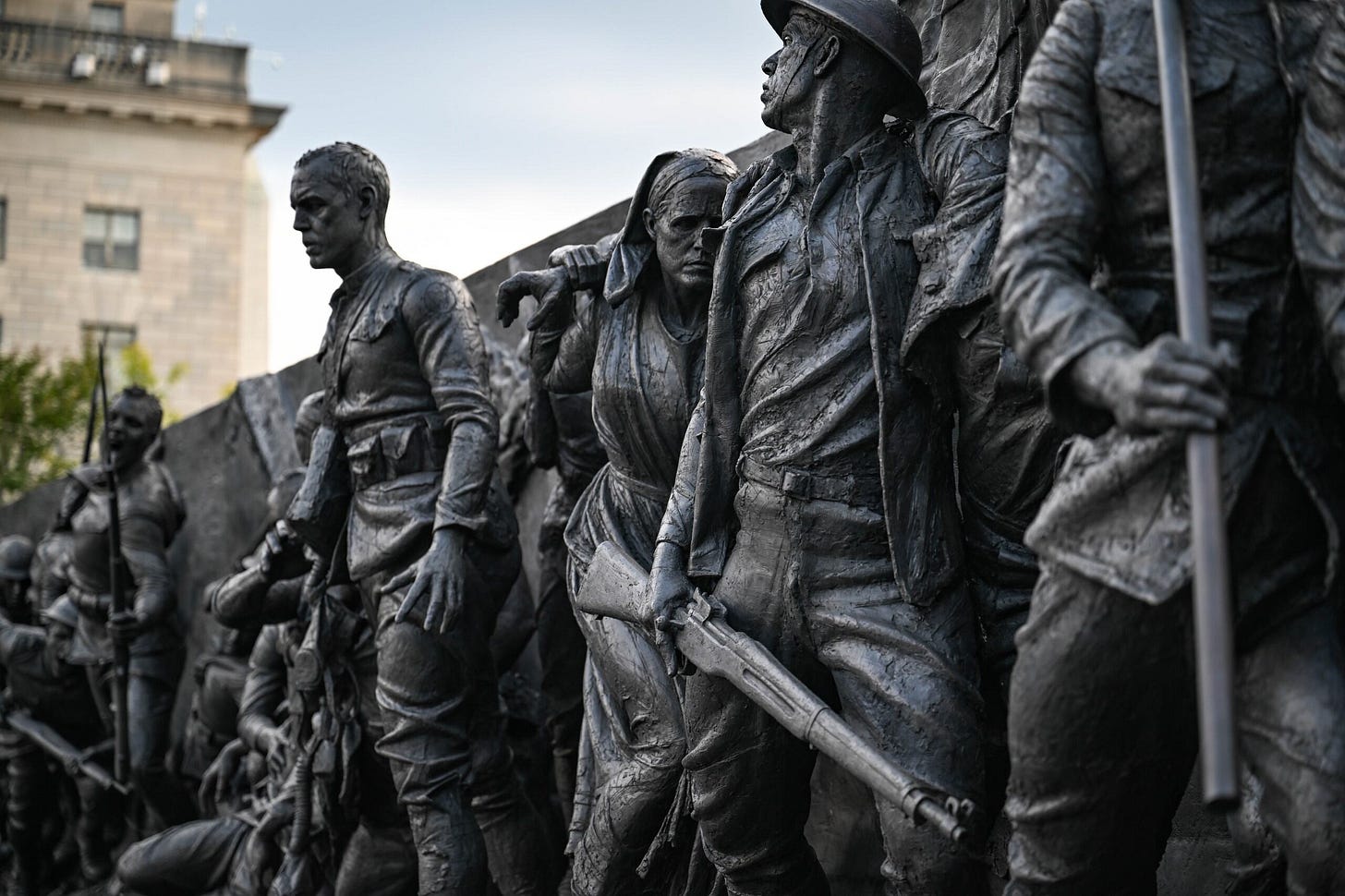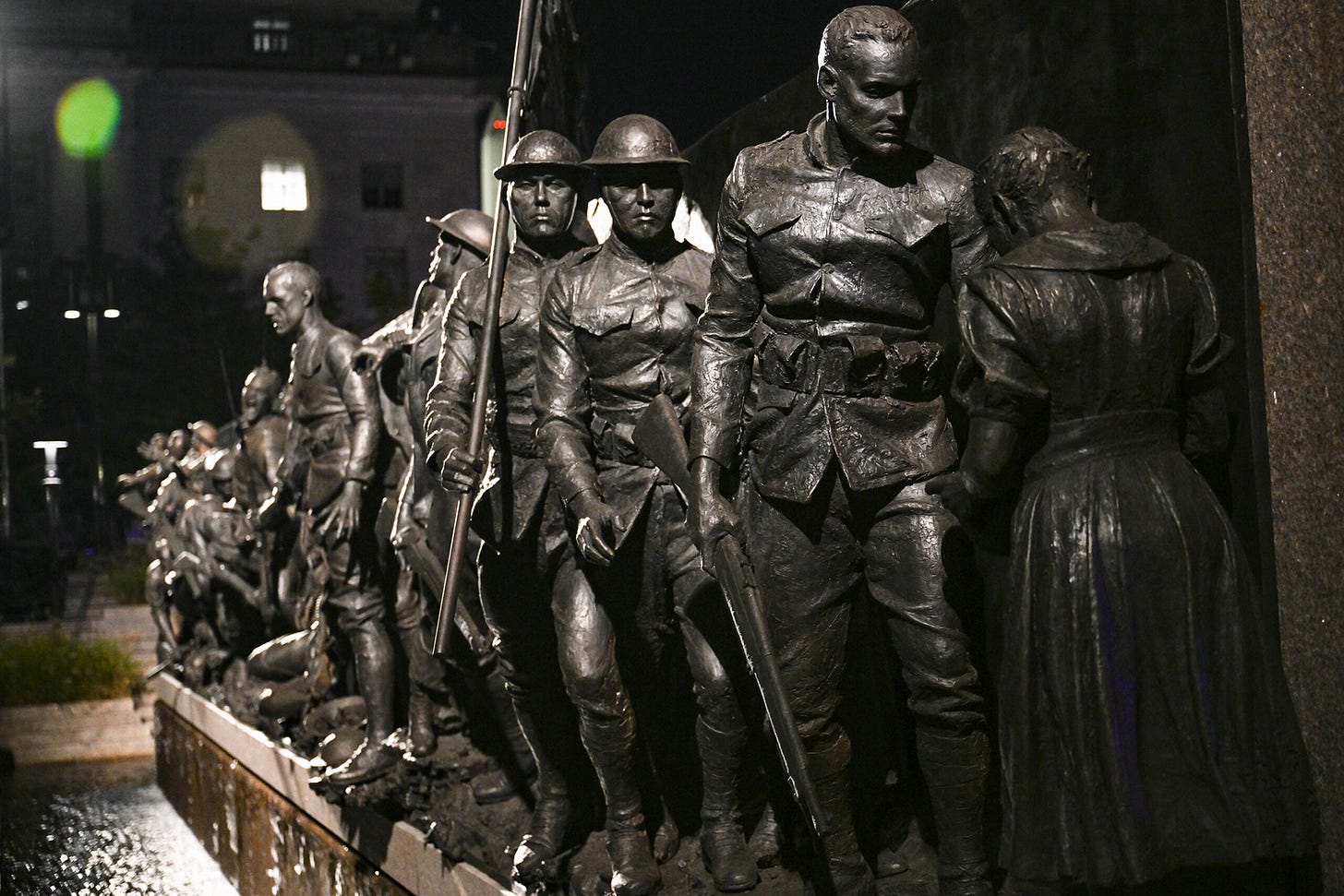There's a choice always – what type of life do I want to have? Do I want to have a life of happiness or do I want to have a life of purpose and I chose a life of purpose.
- Sabin Howard
America’s history is imperfect. But it has also been the best hope for people with something to do or something to say, those who want to make good use of this nation’s liberties and resources. No one alive today understands this and portrays this better than Sabin Howard. His National World War I Memorial is America: big and about big things – unapologetically about strength, honor, courage, and love. We suffer. But we don’t wallow. And these are very human bodies with distinctly masculine bravery and feminine nurturing. While each individual shows the craft of an artist who spent decades studying how to recreate anatomy and anatomical movement, the expressions, stances, and connections are about ideas beyond the corporeal.
My initial reaction: Patriotic? Spiritual? Classical? How on Earth did this get past some government bureaucracy? Doesn’t the American flag exclude others; why not a Djibouti flag? Bayonets should go as they could glorify violence. As a compromise, they could be less pointy. The charge should be more accessible; surely this should include one morbidly obese person. And how was there no call for someone charging in a wheel chair before the arts committee gave its approval?
The answer is Sabin Howard. He didn’t create this by accident. And it got all the above flavors of critiques. He charged no man’s land and against all odds made it across. It was the most American of efforts — built on decades of mastery and years of work. Bold to the point of brazen. Competitive — he competed against hundreds of artists to get the commission, but he wasn’t there seeking permission or offering yet another apology for our history. He was there to win. And he did. So before he packs up to head west on his latest quest, I bring you master sculptor Sabin Howard:
CD: Your work demands physical as well as mental intensity. Your mind has to create something from nothing… but then you need to do it. Long hours of focused craft, on your feet with tools in your hand. How do you prepare?
SH: Humans are physical, as well as spiritual energetic beings. Our ability to transcend the norm and strive for ascendancy into the mythic realm of what is possible is what my art is about. Our gift of life is a journey fraught with resistance. The obstacle is the way to that hollowed and sacred ground of achieving our potential in that time. I do not want to be on my deathbed thinking ‘what if’?
Facing the challenges head on can only make you stronger. Resistance training breeds strength mentally and physically. I do not separate the two. As an athlete and artist I didn't just start day one at making monuments. Year after year, I trained at being a Sculptor. And each year I got better because the challenges became incrementally harder as the bar got higher, and as the years progressed. And as I approached each challenge, there is always a sense of ‘can I actually pull this off’. To make great art requires being in the deep end. If you go a little bit past where your feet are touching the ground in the pool, you are pushed to the next limit. The uncertainty develops a sense of being comfortable in an uncomfortable place.
As an athlete, I train putting myself in a stressful zone. Heart pounding, lungs burning, and quads exploding. This challenge builds a feeling of acceptance physically and mentally that I won't crack — that I am OK in the deep end. Spending time in that uncomfortable place over time brings me to a sense of acceptance that I would not fall apart. I've learned to accept and handle the pain. The tolerance creates immunity to focus performance under duress. Getting used to it breeds confidence that I could handle the problem.
All of this builds the ability to remained focused and on task when the proverbial shit hits the fan. When the stress of being human is present in the challenges of the mission, there is little distinction between the physical and the mental. Our bodies will give out way sooner than our mind will. Therefore any sort of training that increases our mental strength during those stressful moments increases our physical ability to stay on the razor’s edge.
I use bicycling as a challenge to not only become a more physically strong human, but also more adept at dealing with the everyday challenges and problems that life will undeniably gift us. Physical activity is a way to clean the mind and prepare oneself for the challenges that lie ahead. Resistance training cleans the slate and acts as a reset mechanism.
Making monumental figurative art in lineage of the Italian Renaissance requires the ability to remain on point in that focused zone for hours at a time, and for years at a stretch. And the things around you are never a constant. The tide will continue to come in and go out. Being able to pass through dilemmas and difficulties of daily life and the challenges that will inevitably show up out of the blue requires resilience. The bigger the task, the bigger the challenges. It is a guarantee that problems will raise their ugly head when you least expect it. By getting on a bike every day today's problems vanish, replaced by a chemical cleaning of the mind. And sleep is essential for navigating the stress of breaking down barriers. Ideally a hard ride will guarantee that when it is time for lights out, we will be thankful to fall into bed. Setting you up for the next morning to attack yet once again, that mission that drives you daily and gives you purpose. It is a release from the mind's chatter questioning- ‘can I really pull this off’?
Riding a bicycle up a climb or an obstacle will absolutely create tenacity. So, in short, athletic endeavors will increase one's focus, one's tenacity and one's ability to operate under tremendous stress. It's about rising to the occasion as a human. The challenges of making epic monuments that span decades of focused creative work necessitate a strong dose of tenacity and perseverance!
If we feel good in our bodies, we will operate better in our minds. And I have come to the conclusion that we are just going to hurt physically and mentally, so isn't it better to be stronger than weaker in that human condition? That's why I accept the resistance training both on the bike and in life.
CD: Do you get any of your artistic ideas when you’re working out?
SH: Classical figurative monument making is a very esoteric mission. Monuments tell stories. Those stories define who we are. By defining who we are, we create a physical manifestation of our culture. Ultimately this comes down to how do we wish to be represented. If I I am given the responsibility to present to the general public a story that they will understand, I must come up with something that is a universal message. It cannot be some cryptic, mysterious message derived from an Egyptian hieroglyphics carved into granite. That universal visual narrative also must be truly individualistic and creative. There is no room for making art that is generic, boring, and pedestrian. There's plenty of that already in the world. I hold the vision that art must have great depth, meaning and great beauty in appearance. After all art represents who we are, and I do not want to be represented by a banana taped up on the wall as we recently saw at Art Basel in Miami. This is a very challenging profession with little room for error or complacency. I always addressed the challenge as a do or die situation, because if my art wasn't good enough, no one would buy it.
That means that I am in service of those that come to look at the art. I have the potential to create life-changing moments for others, and elevate their consciousness by what I have put together with my hands, my head, and my heart. I cannot just go through the motions. This requires me to be in the moment. The Japanese call it "first time looking." It means that for every time that I pick up a sculpture tool and approach my sculpture, looking at that life model, I have to be in the moment. Focused. Ready to do a battle. I'd liken it to a boxer, stepping into the ring and going through the rounds. Coming out every single time as if it is his last. The attitude I carry in my creative process is one of ‘it has to be a moment that has never happened before in your life’. Show up! And with this experiential action, each moment is vital and visceral and full of passion that will transcend the ordinary and generic.
So you better be in really exceptional shape mentally and physically if you're going to pull off something so challenging. The creation of the sacred requires all of the focus and energy that I have. It has to be delivered day in, day out for years at a time.
There are so many moments where I leave the studio at the end of the day and I feel like a failure. I have not accomplished what I had envisioned. Getting on the bike and challenging myself physically allows the mind to relax and get out of redundant loop-type thinking. It's a release of the mind. All of a sudden the idea of failure will vanish and the thought that the next day is arriving and to pull it off, is on the horizon. But you have to get the chemicals flowing and that means that you can't just ride casually; you have to ride hard. The chemistry allows the unconscious mind to do its work of erasing the negativity that our egos breed. It gives a sense of belonging to something greater than just the corners of one's imagination, and that there are powers that we can tap into allowing us to rise to the occasion as the sun rises the next morning and we head to work.
This does not happen unless exertion rate is so high that you have to stop thinking about the day and get in the moment of maintaining the force and energy for a duration of time. Your mind automatically must change gears, and when this happens, the unconscious mind is allowed to flourish and bring us great creativity. The caveat is you must be listening, and you have to suffer a little bit to get there. Embrace the suffering; embrace the obstacle.
CD: What do you eat? How do you fuel a day of long hours and tons of material that you take from amorphous blocks and turn them into something with structure and meaning?
SH: I am a big proponent of routine. Routine involves discipline. Going to bed at a certain hour and being able to get X amount of hours sleep guarantees stronger mental health, and physical recovery from the pounding that constructing over life-size clay figures take on a body. The better shape I'm in, the better I can perform mentally and physically on that studio floor.
I wake up every morning stiff and sore. It is completely necessary that I do the work to oxygenate and lubricate my joints. Eating correctly allows exercise to continue. Remember: an object in motion tends to stay in motion.
Processed food is poison. I eat zero processed sugar. All of my protein comes from fish, chicken, and a lot of meat that is devoid of chemicals and cattle fed soy products. I also try to get at least 30 different fruits and vegetables in every week. And in the last few years, I really don't drink anymore.
At the age of 61 I have become more aware that I am terminal. If I do not have my health, I do not have anything. I will not be able to perform and heal. My health is my number one priority. Without my health, I can forget about doing anything else. I would rather create my own present, than let someone else create it for me. So I take responsibility that the healthier I can be in my food choices the better I will perform in the studio. And that time in the studio will be limited to how long I can get up and put myself in that brutal, creative zone of making monuments. Pay now or pay later.
I do have to be honest. I love black coffee and usually have 3 cups a day.
I take a lot of vitamins and minerals, but I've moved away from the health business, powders, and supplements. I believe that God can create things far better than technology. And honestly, I don't trust a lot of the companies and what is on the label.
CD: How do you measure your fitness? How do you recover?
SH: Consistency is the prescription for massive success. Showing up day in day out even if you don't feel like it, even if it hurts, even if your best friend died will deliver the next level of what is possible. The day that I picked up Drawing On The Right Side of The Brain, a book for beginners, and sat down at a desk with a pencil and paper, and began drawing the objects across the room, was the first day of my journey towards having purpose and meaning. It was October 22 at 4 PM and I could not draw. I started at zero. But I had a vision that Art was the world of Michelangelo, Leonardo, and Raphael.
Humans crave having a purpose. Humans crave belonging to something bigger than themselves. When I began drawing every day, I approached it exactly the same way as I approached my athletic training. Show up, do the work, and be consistent. Practicing the art of visual observation and recording it on paper changed the way that I perceive my reality. The practice elevated my spirit because I looked outside of myself at my surroundings. This activity took me out of ego and plugged me into the universe. Over the years I have grown in the understanding. I am only a small cog in a huge unit made up of so many trillions of parts, all acting in unison, constructed in Divine hierarchy of wholeness.
Sports does the same thing. I constantly challenge myself to see how long I can stay in a difficult taxing physical zone. I create weekly challenges and goals. Picking goals along the way to develop me physically and mentally and make my time on earth way more meaningful!
If I know I can do something where is the challenge? Being on the sharp edge creates uncertainty, and ultimately that makes us try harder. And when the pain is over, there is a sense of accomplishment. Accomplishment in a task that years ago seemed impossible now all the sudden becomes reality. And as we climb that ladder this process of pushing the limits and getting more comfortable in that higher level only opens the door to achieve the unachievable.
CD: Media reports your age in the 60s but that is almost inconceivable for someone who looks and moves like someone in his 40s. The idea of your being near “retirement age” is laughable. Any plans to close up shop, wind down, and retire from a life of intense creativity and movement?
Yes, I am 62 this year. And I just finished making a 60 foot bronze sculpture, with 38 figures that weighs 25 tons. What is the next level? What can I achieve next. I plan on making a larger monument tackling a story that is even more complex than a national World War I memorial. I am in service of what is sacred and what is valuable to the world. I will move with my family to Utah in the next 10 days and set shop in Salt Lake City. I will bring together other sculptors and we will create the American cultural renaissance.
For 42 years I have fought against modernism, and its anti-aesthetics. It's time to return Art to We The People.
Tradition is not the worship of ashes, but the preservation of fire! And I have a lot of fire in my belly still, and know what I am capable of. We're going to up the ante one more time.
In a moment where history and values are being challenged and torn down, I stand in the brink. I grew up in the visual splendor of Italy, and it touched my heart. I will never relinquish the meaning of the sacred and beautiful for humanity. It is my job and my mission to play it forward from those legends and heroes of Western Civilization.
So no I am not retiring. I'm getting in my ark and I'm going to row. I'm going to row forward and play it forward. I will never retire. I will die with my Sculpture tools in my hands. I have had a year away from sculpture, clay, and life models, and that is the last year I vowed that I will ever take outside of the studio.
And I'm planning on challenging myself on the bicycle in the mountains of Utah!
Let's see what we can do and what we are capable of. Otherwise, what the hell is the point.








"Tradition is not the worship of ashes, but the preservation of fire!"
This is gold. And fire.
Scholar. Warrior. Poet.